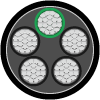Automation Industry
In the automation industry, cables are essential for various applications, primarily in the following areas:
1. Sensor and Actuator Connections: Sensors and actuators in automation systems typically require cables to connect them to control systems, facilitating the transmission of data and control signals. For example, various sensors (such as position and force sensors) and actuators (such as motors and cylinders) in industrial robots depend on cable connections.
2. Control System Connections: Control systems in automation require cables to link various devices and components, enabling the transmission of control signals and data. These systems may include PLCs (Programmable Logic Controllers) or other types of controllers.
3. Power Transmission: In automation systems, certain equipment and components demand high-power supply, which is delivered via cables connecting the power source to the equipment and components.
4. Communication Networks: Devices and components within automation systems often need to connect to a network. Cables are used to link these components to network switches, routers, or other communication devices, enabling seamless data exchange.
5. Safety Systems: Automation systems typically integrate safety mechanisms, such as safety sensors and emergency stop buttons, which are connected to the safety control system through cables. These connections are crucial for ensuring operational safety.
In summary, cables play a vital role in transmitting power, signals, and data within the automation industry. They are fundamental to the smooth and efficient operation of automation systems and their various functions.











